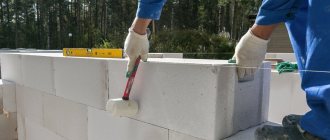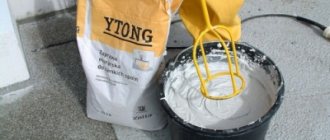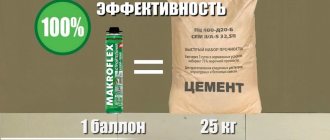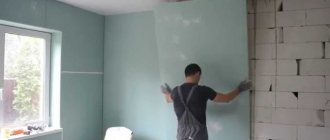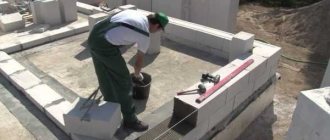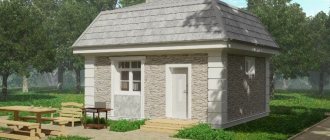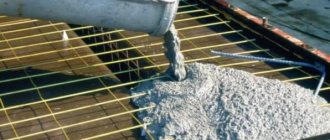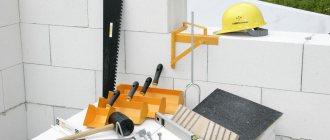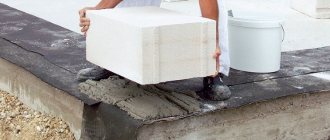Construction from aerated concrete involves laying walls from blocks in compliance with a certain technology. The main task is what to place aerated concrete blocks on?
Let's consider the types of solutions, foam, mixtures and adhesives for laying gas blocks. A comparative analysis of characteristics and properties will allow you to make the right choice. You will find out which glue is better, how much is consumed, when and how to use it, the cost of different manufacturers + tips on preparation and application.
In practice, several types of adhesive mixtures are used for laying aerated concrete. However, there are only two popular options:
Composition of special glue
Adhesive for aerated concrete blocks contains the following components:
- High quality Portland cement.
- Fine grain sand.
- Polymer substances to improve properties.
- Auxiliary modifiers for better strength and other characteristics.
Previously, when aerated concrete blocks just began to be actively used, their laying was done using ordinary mortar. However, the concrete drew out the liquid very quickly, causing the strength to decrease significantly. When specialized adhesive for aerated concrete appeared, the situation changed for the better.
The special composition began to take up less space, and mixing became easier. But despite all this, the cost of the work has not increased, because the consumption of improved glue is much less.
The composition of the aerated concrete masonry adhesive ensures optimal fluidity for filling small pores, which makes it possible to fasten the blocks together with high quality. What’s also good is that manufacturers add various modifiers to the composition to improve quality.
Reference! Additional elements that are included in the glue reduce the thermal conductivity of the mixture. With a layer of 3 mm, heat loss through the connections is minimal.
However, for high-quality work, the blocks themselves must meet a number of requirements. For reliable fastening, their surface must be smooth. The glue layer itself is very thin, so it will not be possible to level the surface and hide visible defects.
Useful video
Foam glue for construction and installation work is a new material, although polyurethane has been used in the national economy for a long time and quite successfully. The attitude of builders and private developers towards it is ambiguous. Opinions vary radically, as evidenced by reviews of this material and the quality of laying blocks on foam. Adhesive foam is an economical material. It does not require much time to prepare it for work, and this is why builders like it. Labor productivity thanks to polyurethane glue increases significantly. It provides high adhesion to blocks. And this is also an attractive factor. But one thing still raises concerns - how the foam glue will behave in 10, 25, 50 or 100 years.
Types of glue
Modifiers in the composition of adhesive for aerated concrete blocks give individual compositions unique properties, which allows them to be used in certain conditions. For laying blocks, there are 2 types of adhesive mixture - summer and winter. The last option is all-season; it has no restrictions for use in the warm season. As for summer, its use is permissible only at above-zero temperatures, which limits the scope of use.
Summer
The adhesive for summer blocks contains white cement. The finished seam practically does not stand out against the background of the gas block, which looks neat and aesthetically pleasing. This feature makes it possible to do without additional finishing. Representatives: MixMaster, Kreps.
The use of summer glue for blocks is permissible at a temperature of at least +4 degrees. At a minus value, crystallization occurs and the quality of the mixture deteriorates greatly.
Reference! When during construction there is a possibility that the temperature will drop below 4 degrees Celsius, winter glue should be used.
Winter
Winter glue already contains modifiers that prevent the liquid from freezing and increase the plasticity of the finished mixture. Can be used down to -15 degrees. The downside of the composition will be longer hardening, which prolongs the working time. After mixing, it can be used for several hours, but ordinary glue loses its properties after half an hour.
Winter adhesive for gas silicate and aerated concrete blocks cannot boast of aesthetics. After hardening, it becomes dark and differs significantly from the base material.
Reference! In winter, at sub-zero temperatures, glue consumption increases, but this is only a plus for the strength of the connection.
How to lay aerated concrete blocks - step-by-step instructions
Laying walls made of aerated concrete blocks is somewhat different from work carried out using sand mortars. The main rule that is observed during work is to apply the adhesive only to a carefully prepared surface of the block. It should be free of dust, ice and other foreign substances. The main stages of work consist of the following steps:
- inspection and cleaning of blocks,
- preparation of adhesive composition,
- applying the solution to the blocks,
- installation of blocks and their alignment,
- cleaning masonry from excess glue.
It is worth noting that preliminary moistening of aerated concrete blocks during work is not required. However, in hot weather it may be necessary to slow down and stabilize the hardening of the mortar. It is advisable to cover the finished masonry with a tarpaulin or burlap until the glue has completely set.
Proportions for preparing the solution
Features of preparing high-quality glue for blocks:
- You should read the instructions for the product, even if you have previously had experience working with it, because different manufacturers may have different properties and preparation methods.
- For 10 kg of mixture, take about 1.5-2.5 liters of liquid.
- First, water is poured into the container, then the powder is poured. If you do the opposite, lumps will form, and removing them will be problematic.
- For mixing, it is better to use a construction mixer, which is turned on at low speed.
- After obtaining the desired consistency, you need to wait a few minutes and then mix again.
Reference! After preparation, the mixture can be used within 30 minutes, for winter formulations - 2-3 hours. After this time, the properties of the solution begin to deteriorate.
The glue should be mixed in portions, because if it is not used at the specified time, a new solution will have to be prepared, which significantly increases consumption. At any time of the year, it is recommended to maintain the glue temperature at least +10 degrees.
Material consumption is individual for each individual brand. The air temperature during operation also matters. The average consumption is about 15-20 kg per meter. At the same time, some mixtures are used in significantly smaller quantities - up to 2 kg per meter. Consumption will depend not only on the characteristics of the adhesive, but also on the quality of the blocks themselves.
The most popular brands of foam adhesive for masonry blocks and their average price category
TYTAN Professional
Adhesive compositions based on polyurethane under the Tytan brand are produced at the Russian enterprise Selena Vostok. Tytan 60 seconds adhesive foam with a cylinder capacity of 750 ml is one of the professional building materials. It has a wide range of applications. In addition to laying aerated concrete, Titan adhesive foam is used for gluing polystyrene, mineral wool (insulation), plasterboard, silicate materials, etc.
Foam adhesive TYTAN Professional for masonry blocks gives 40 meters of adhesive strip
There is no expansion when drying. It hardens completely within 1 hour. According to manufacturers, one aerosol can can replace 25 kg of dry foam glue or the same amount of masonry mortar.
The average price category of TYTAN Professional on the Russian market is about 1000-1200 rubles.
Ceresit CT 115
Ceresit is a German manufacturer. However, production facilities are located in other countries, which helps maintain budget prices for materials produced under this brand. For example, foam adhesive Ceresit CT 115 with a cylinder volume of 850 ml costs on average 400 rubles.
Adhesive foam Ceresit CT 115
This is white glue. Its application temperature is -5 to +35°С, operating temperature after drying is –40 to +90°С
TechnoNIKOL
TechnoNIKOL foam adhesive is used for laying aerated concrete blocks and other foam concrete. Characteristics of this brand of foam adhesive for aerated concrete:
- The composition is blue;
- Complete polymerization time is 24 hours;
- The volume of the aerosol can is 500 ml;
- The temperature at which this foam adhesive is used is from −10°C to +40°C.
TechnoNIKOL adhesive foam for aerated concrete blocks
The average cost of the TechnoNIKOL building mixture with a capacity of 500 ml, intended for aerated concrete blocks and masonry, is 1,200 rubles.
Makroflex
Makroflex adhesive foam is available in aerosol cans with a capacity of 850 and 1000 ml. The area of the glued surface is 12 square meters. meters. Drying time, after which you can proceed to the next stage of work, is 2 hours.
Makroflex foam cement for foamed aerated concrete
Makroflex foam cement is resistant to moisture and mold. It's convenient to work with her. Saves up to 50% of working time. The average price of an 850 ml cylinder is 300 rubles.
The best manufacturers of adhesives
There are many companies that produce glue specifically for aerated concrete blocks. However, some manufacturers are the most popular, including Ceresit (Henkel), Knauf, Kolmiks, Volma, Prestige, Kreps.
Review of adhesives from well-known and trusted companies:
- Henkel. Produces materials under the Ceresit brand. Special glue is popular in many countries and there is no doubt about its quality. Ceresit ST 21 is used for laying blocks. The company produces winter and summer versions of the product. With a layer of 2 mm, the cost is approximately 17.5 kg.
- Colmix. Produces Stroy Moment SMK-10. Can be used for work in winter; the product contains auxiliary components that prevent freezing. Consumption - about 20 kg per meter.
- Volma. “Blok” adhesive is produced for cellular concrete. Consumption is about 1.4 kg per meter, which is very little for a 1 mm seam.
- Craps. KGB Kreps is being prepared specifically for blocks. For masonry you need a 2 mm seam. After mixing, you can use the solution for 4 hours. Suitable in conditions from -10 degrees.
- Prestige. Mixtures for foam concrete and aerated concrete are being prepared. The finished solution retains its quality for 3 hours. Seam thickness – 5 mm.
- Aerok. The plant prepares adhesive for various blocks. There are 2 composition options in the range, which allows you to use the manufacturer’s products in winter and summer at temperatures from -15 to +35 degrees. The layer is applied 3 mm thick. Consumption – 15-18 kg per meter.
- Eunice. In addition to laying aerated blocks, the composition can also be used for plastering. The product allows you to correct minor defects, chips, cracks.
To preserve the quality of the glue, it should be stored in an airtight container. In the room where the composition is located, the moisture level should not be higher than 70%. In winter, glue should be left in a heated room. Open packaging must be protected from moisture to prevent petrification. The diluted solution is not stored, it is suitable for use within 2-3 hours.
Ceresit
Ceresit ST 21 is an adhesive made specifically for silicate and lightweight concrete blocks. It has high quality indicators. Among the positive aspects are water resistance, frost resistance, and use indoors and outdoors. It adheres well to cellular concrete, providing additional thermal insulation.
The glue is produced in 25 kg bags. The composition contains polymer components, mineral fillers, and cement. Application temperature range – from -5 to +30 degrees.
Preliminary preparation of the surface is required - cleaning from dirt, eliminating chips and damage. You can level the base with the same glue from Ceresit. Each row of blocks should be carefully sanded using coarse sandpaper. Don't forget to remove dust.
Cooking features:
- The mixture is slowly poured into the liquid at room temperature.
- Mixing is done with a drill with an attachment or a mixer.
- The finished solution is infused for 5 minutes.
- Re-mixing is done.
- The solution can be used up within 2 hours.
Reference! The advantages of ST 21 glue will also be environmental friendliness and safety for humans.
Knauf
Knauf glue is one of the most popular building materials on the market. It is produced in packages of 15 and 30 kg. Knauf Perlfix is a mixture on gypsum with additional components. Suitable for various surfaces, including concrete, foam concrete, brick slabs. Can only be used indoors.
The product is made from environmentally friendly materials. The glue is safe for humans both during operation and after hardening. The company has a quality certificate for each product. At the same time, glue also has some disadvantages. The mixture takes a relatively long time to dry, which is due to its special composition. It will take a week to completely harden. During this time, the adhesion strength will increase.
Ivsil block
Another high-quality glue for blocks is Ivsil Block. It contains fractionated sand, cement and auxiliary polymers. Suitable for grooved and grooveless blocks. A distinctive feature will be increased plasticity. After application, it is possible to adjust the position within 10 minutes.
For masonry, a 2 mm layer of glue is required, which significantly saves its consumption. There are summer and winter versions of the mixture. A small layer of application also prevents freezing of the wall and the formation of cold bridges. After mixing, use within 3 hours.
Experts recommend choosing proven brands of glue for blocks that receive good reviews. When using, you must follow the instructions provided by the manufacturer.
Using glue for aerated concrete blocks (2 videos)
Adhesive for aerated concrete blocks (18 photos)
Criterias of choice
The selection and purchase of the optimal adhesive composition must be accompanied by compliance with certain criteria. A specialist consultant in a hardware store must take into account the following factors in order to determine which adhesive for laying gas silicate blocks is better:
- Manufacturer and brand. Popular manufacturers of building materials take care of their reputation and carefully monitor the quality of their products. Products from such a manufacturer are more expensive, sometimes several times more. However, if impeccable quality is required, the choice should be made in favor of such brands. By the way, very often in construction stores and showrooms there are promotional offers on products from well-known brands.
- Conditions under which the substance is stored. All dry concentrate must be located in a ventilated area. If the product is located on shelves where there is high humidity, or the packaging is damaged, it is considered unsuitable, since it can reduce the quality of the masonry.
- If possible, the choice should always be made in favor of a manufacturer that supplies not only glue, but also gas silicate blocks.
- The main factor: before purchasing, you should always calculate the material (amount of glue) required for construction.
You need to be guided by the following formula: if the layer thickness is no more than 3 mm, then 8-9 kg of composition will be required per 1 m3 of surface.
Common mistakes
Several categories of errors can be distinguished depending on the consequences that appear later.
Actions that violate the integrity of structures
Any miscalculations in the future increase the likelihood of cracks forming. In turn, they lead to a decrease in strength and collapse.
Here is a list of the main errors that are most often encountered in practice:
- The use of bricks to protect insulation together with expanded polystyrene.
- Mistakes associated with bandaging or mating. Creating flexible connections can be called a mistake.
- Armored belts are incorrectly positioned or absent altogether.
- Incorrect arrangement of the foundation, erroneous choice of soil or type of structure, use of different types of foundation in the same building.
- The structure of the trees located nearby was not taken into account.
- Lack of compaction and improper work with underlying layers.
Which leads to unnecessary labor and financial costs
It is because of the mistakes described above that owners have to spend much more money, while none of the expenses pay off. It also takes more time, although the final quality does not change in any way.
The use of ceramic bricks in the first rows is not able to correct mistakes made when arranging the foundation. You should not install reinforcement where it is not initially required.
Additional information about installation technologies
Already at the preliminary stages, the following actions are carried out so that the strength of the masonry becomes maximum:
- Preparation of the solution. A good composition requires special attention.
- Checking the foundation in all areas. It should remain as horizontal as possible throughout.
- Provide additional protection from moisture using bitumen mastic.
Roofing felt for waterproofing is not as effective, but in some situations it can replace analogues.
More detailed description of the technology
The acquired knowledge and skills help to create durable and smooth surfaces that have all the necessary characteristics.
The first element is laid or installed in the corner. Then they continue to move sequentially until the next turn. A thickened layer of mortar helps to cope with any possible defects in the foundation. The main thing is that the height of the corners is approximately the same. The deviation should not exceed 3 centimeters.
When used correctly, the approximate cord also creates the most even line possible. To achieve this effect and maintain it, you need to pull this cord with corner blocks, with the obligatory use of intermediate beacons. At this stage, building levels become indispensable assistants. A hacksaw is used when adjusting blocks when it comes to structures of increased complexity.
Reinforcement is required not only for the space under the windows, but also for rows with numbers divisible by five.
Laying with glue is carried out only in a certain temperature range, from -5 to +20-25 degrees. If the days are hot, the material can be slightly moistened while working. Protective awnings or films are necessary when precipitation is present. Then the seam and masonry will dry correctly.
A stainless steel bond is required when it is necessary to create areas where walls join together with internal partitions. As a result of this work, a seam appears, which can only be fixed with ordinary nails. It is recommended to add such components to each even row of masonry.
When construction is completed, natural shrinkage occurs, which takes up to several months.
About reinforcement
When reinforcing, several problems are solved during installation:
- Strengthening those areas where the masonry is weakened. This is mandatory for all types of openings.
- Providing additional protection for the building perimeter. It is especially important with an increased degree of ventilation and during shrinkage, in case of temperature changes.
- With vertical reinforcement, it becomes possible to combine the base with a monolithic frame. Such approaches are relevant for regions with increased ground displacement and hurricanes.
The frame is made of steel wire, usually everything is arranged in one layer. The reinforcement elements are located parallel to each other. It doesn’t matter whether it’s an apartment or another object.
You need to create two grooves using a wall chaser. Then they are soaked in water and filled halfway with glue. It is necessary to place it inside fittings with a standard size of 8 millimeters. Next, everything is filled to the brim with the binding composition. Using adhesives is not that difficult.
How to check the correctness of the masonry?
The evenness of those laid side by side is checked regularly while construction is underway. The same applies to the thickness of the adhesive layer, which is used for strengthening. Construction measurements require a minimum set of tools:
- Building level.
- Rule.
- Ruler.
During the inspection, the rule is leaned against a section of the wall that has already been erected. If everything is according to technology, then there will be a tight connection. A building level is placed on top of the stacked blocks. His readings should be enough to determine the horizontal line.
The site must be rebuilt if there are any deviations. Otherwise, the masonry will not be of high quality.
Before starting work, a foam container must be prepared. To do this, it is placed in a warm room for 10-12 hours. In warm weather, you can do without these steps.
It is recommended to apply several vertical strips of glue at once to ensure a better bond. If a gun is used, keep the cylinder in an inverted position. The nozzle, which looks like a truncated body, is located a centimeter from the surface of the block.
The thickness of the block itself determines exactly how many stripes are applied to the surface. The width of these strips themselves is 2-3 centimeters. The main thing is that they are not interrupted. Various modern technologies are used for installation.
Hygroscopicity of aerated concrete
The ability of aerated blocks to actively absorb water turned out to be a serious problem. All types of concrete tend to absorb moisture, but they release it fairly easily once the right conditions arise. However, aerated concrete not only absorbs moisture, but accumulates it in cavities. Drying aerated blocks is not easy; you need to create the appropriate conditions and give enough time to complete the process.
This feature of the material created two problems:
- inability to use conventional masonry mortar due to water absorption and violation of the hardening regime;
- the inadmissibility of the occurrence of cold bridges on load-bearing walls due to condensation settling and wetting of gas blocks.
The danger of walls becoming wet lies in the tendency of the material to accumulate moisture. In winter, it freezes and begins to expand, tearing apart the walls from the inside. This process is invisible and is determined only at a late stage, when the destruction of the walls reaches serious proportions. It is for this reason that thin-seam aerated concrete masonry technology is used, when the permissible thickness of the seams does not exceed 4-5 mm. With such a thickness, cold bridges cannot form, since the gas blocks surrounding the top and bottom give up some of the thermal energy to heat the seams. If you use a regular solution with a layer thickness of up to 2 cm, the energy of the blocks will not be enough and cold bridges will appear. Condensation will begin to settle, the walls will get wet and will gradually begin to collapse.
Features and properties of aerated concrete
Aerated concrete is a specific building material from the group of cellular concrete. It has a porous structure that makes it unlike traditional types of concrete. The main components of the material are the same as those of dense grades of concrete - cement, sand and water. However, lime and aluminum powder (paste) are added to the composition as a gas-forming agent. It is these additives that give aerated concrete its specific properties. During production, all components are thoroughly mixed and water is added. A chemical reaction of lime with aluminum powder begins, accompanied by active gas evolution. The aerated concrete mass swells and rises like yeast dough (that’s what manufacturers call it at this stage). When the reaction is complete, the material acquires a porous structure with many small bubbles of carbon dioxide (2-4 mm). After this, the mass is cut into blocks and treated with hot steam under pressure (autoclaved aerated concrete) or without pressure, simply kept in an atmosphere of hot steam (naturally hardening aerated concrete).
The resulting material has a lot of specific properties that sharply distinguish it from traditional dense concrete:
- light weight. This is the most important quality that allows you to reduce the cost of building a foundation, as well as facilitate the unloading and laying of blocks;
- low thermal conductivity. Walls made of aerated concrete are able to retain and accumulate thermal energy, which allows saving on space heating;
- the even and precise geometric shape of the blocks allows the thickness of masonry joints to be minimized.
The list of advantages of aerated concrete does not end here, but it is not advisable to list it in its entirety. It is more important to consider the disadvantages of aerated concrete:
- low strength. Aerated concrete is not able to withstand high pressure, as the air cavities collapse and the material sags;
- hygroscopicity. The material is capable of absorbing moisture up to 25% of its own weight;
- inability to tolerate multidirectional (tensile) loads.
These features of the material forced builders to reconsider construction technology and develop their own masonry technique.
